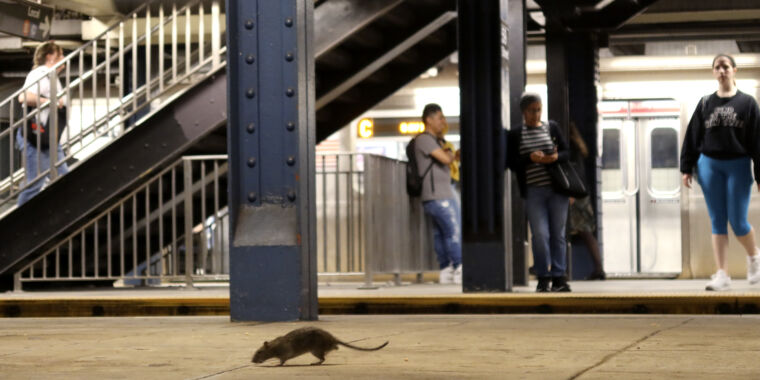Life-threatening rat pee infections reach record levels in NYC

Epeedemic —
Between 2001 and 2020, there was an average of 3 cases per year. Last year’s tally was 24.

Enlarge / A rat looks for food while on a subway platform at the Columbus Circle – 59th Street station on May 8, 2023, in New York City.
A life-threatening bacterial infection typically spread through rat urine sickened a record number of people in New York City last year—and this year looks on track for another all-time high, the NYC Department of Health and Mental Hygiene reports.
The infection is leptospirosis, which can cause a range of symptoms, including non-specific ones like fever, headache, chills, muscle aches, vomiting, diarrhea, and cough. But, if left untreated, can become severe, causing kidney failure, liver damage, jaundice, hemorrhage, bloody eyes (conjunctival suffusion), respiratory distress, and potentially death.
The bacteria that causes it—spirochete bacteria of the genus Leptospira—infect rats, which shed the bacteria in their urine. The germs jump to people through direct contact with open wounds or mucous membranes.
New York City has long been in a (mostly losing) war with its rat population, which last year was estimated to be as many as 3 million. Mayor Eric Adams has made fighting the rat population a key initiative, and just last week, the city council proposed the latest strategy to curtail the furry brown rodent’s colony: birth control in the form of salty pellets.
Still, leptospirosis has not been a prime concern from the rats’ mischief until recently. Between 2001 and 2020, the city logged an average of just three leptospirosis cases a year—and some of those were travel related. But, things took a turn during the pandemic when the rat population seemed to boom. From 2021 and 2022, the average shot up to 15. In 2023, there were 24 cases, the highest number of cases ever recorded for a single year. And as of April 10, there have been six cases so far.
That number of cases so far this year is concerning given that Leptospira bacteria are “fragile,” as the NYC health department puts it. They die quickly in the freezing temperatures of winte and the dry heat of summer. Their main time to thrive is in warm, moist conditions. Last year, the months with the most cases were June and October. The health department noted that climate change, which is causing excessive rain and unseasonably warm temperatures, may be partly driving the uptick in cases.
In a health advisory released last week, the city’s health department advised clinicians to be on the lookout for cases, which are treated with common oral antibiotics when mild or intravenous doses when severe. Symptoms typically develop in 5 to 14 days after an exposure, but can show up anywhere from 2 to 30 days.
Of the 98 locally acquired cases that the city has recorded between 2001 and 2023, nearly all were in men (94 percent) and the median age was 50, with a range of 20 to 80 years. Most often, the cases occurred in the Bronx (37), followed by Manhattan (28), Brooklyn (19), Queens (10), and Staten Island (4). Cases presented to clinicians with acute kidney and liver failure and occasionally severe respiratory involvement. Of the 98 cases, six died.
The cases are typically related to living or working environments with rat urine, contaminated soil and water, or materials frequently contaminated with rat urine, such as trash bags or food waste bins. The health department noted that human-to-human transmission is rare.
New York isn’t the only city plagued by leptospirosis cases. Last year, doctors in the Netherlands reported the case of an 18-year-old with jaundiced, bloody eyes, who had developed leptospirosis after falling into a canal that was likely contaminated with rodent urine.


